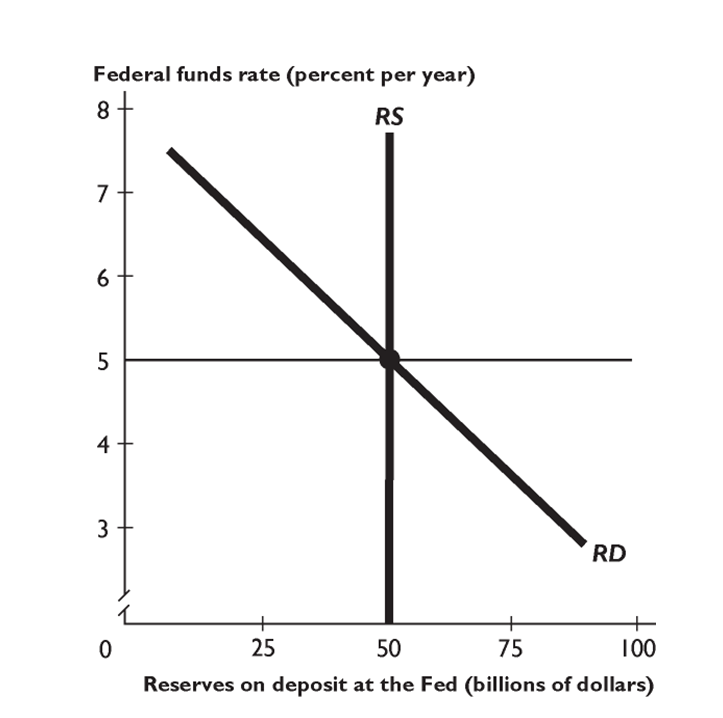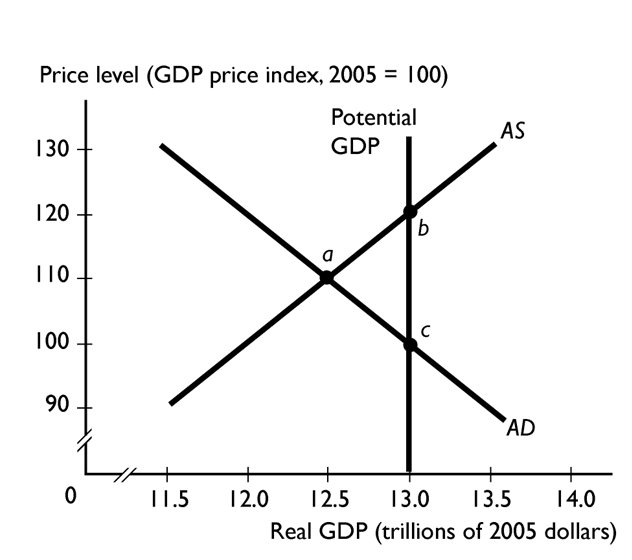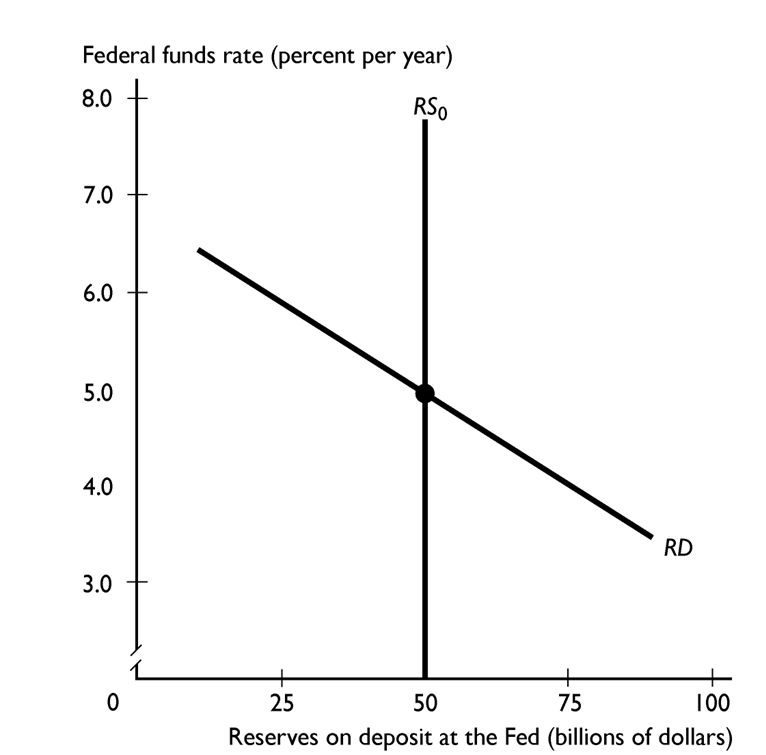A) rises; increase
B) falls; decrease
C) rises; decrease
D) falls; increase
E) does not change; increases
Correct Answer

verified
Correct Answer
verified
Multiple Choice
 -
If the Fed wants to increase the federal funds rate, it will conduct an open market operation in which it --------------------government securities and thereby shifts the-------------------- curve -------------------- .
-
If the Fed wants to increase the federal funds rate, it will conduct an open market operation in which it --------------------government securities and thereby shifts the-------------------- curve -------------------- .
A) sell; RD; leftward
B) buy; RS; leftward
C) sell; RS; rightward
D) buy; RD; rightward
E) sell; RS; leftward
Correct Answer

verified
Correct Answer
verified
Multiple Choice
If the Fed is concerned about a possible recession, it-------------------- the federal funds rate, which-------------------- the quantity of reserves and-------------------- the amount of bank loans.
A) raises; decreases; decreases
B) lowers; increases; increases
C) lowers; decreases; decreases
D) raises; increases; increases
E) lowers; increases; decreases
Correct Answer

verified
Correct Answer
verified
Multiple Choice
Which of the following are policy instruments available to the Fed as it tries to achieve its macroeconomic goals? I. government expenditure on goods and services and taxes ii. the government budget deficit or surplus Iii. changes in the federal funds rate
A) ii only
B) iii only
C) i and ii
D) i and iii
E) ii and iii
Correct Answer

verified
Correct Answer
verified
Multiple Choice
When the Federal Reserve increases the federal funds rate, bank loans-------------------- , the supply of loanable funds --------------------, and the real interest rate --------------------.
A) increase; increases; falls
B) decrease; decreases; rises
C) increase; increases; rises
D) does not change; decreases; rises
E) decrease; does not change; rises
Correct Answer

verified
Correct Answer
verified
Multiple Choice
The federal funds rate is--------------------of the Fed.
A) an objective
B) a technique
C) a goal
D) a monetary policy rule
E) the monetary policy instrument
Correct Answer

verified
Correct Answer
verified
Multiple Choice
 -
The economy is at the equilibrium shown at point a in the above figure. If the Fed
-
The economy is at the equilibrium shown at point a in the above figure. If the Fed
A) buys government securities, the economy moves to an equilibrium at point b.
B) sells government securities, the economy moves to an equilibrium at point b.
C) sells government securities, the economy moves to an equilibrium at point c.
D) buys government securities, the economy moves to an equilibrium at point c.
E) None of the above are correct because the economy will remain at point a if the Fed buys or if the Fed sells government securities.
Correct Answer

verified
Correct Answer
verified
Multiple Choice
A decrease in the federal funds rate
A) decreases the demand for loanable funds, lowers the real interest rate, and decreases aggregate demand.
B) decreases the supply of loanable funds, raises the real interest rate, and decreases aggregate demand.
C) increases other short-term interest rates, decreases investment, and decreases aggregate demand.
D) lowers other sort-term interest rate, raises the real interest rate, and increases aggregate demand.
E) lowers the exchange rate, increases the supply of loanable funds, and increases aggregate demand.
Correct Answer

verified
Correct Answer
verified
Multiple Choice
Which of the following are TRUE regarding Milton Friedman's k-percent money targeting rule? I. Currently this policy is used by many policy makers. Ii. This rule sets the growth rate of the quantity of money independently of the economy's behavior. Iii. For this policy to work well, the velocity of circulation must be stable.
A) i only
B) i and ii
C) ii only
D) iii only
E) ii and iii
Correct Answer

verified
Correct Answer
verified
Multiple Choice
Which of the following statements are correct? I. The Federal Reserve's monetary policy must be approved by the President of the United States . Ii. The Federal Reserve Board of Directors meets approximately every six months to review the state of the economy and determine monetary policy. Iii. The Federal Reserve has determined it will use the monetary base as its policy instrument.
A) iii only
B) ii only
C) i and ii
D) i only
E) None of the above answers is correct.
Correct Answer

verified
Correct Answer
verified
Multiple Choice
The higher the federal funds rate, the --------------------the opportunity cost of holding reserves, which-------------------- the incentive to economize on reserves.
A) lower; increases
B) lower; decreases
C) higher; increases
D) lower; does not change
E) higher; decreases
Correct Answer

verified
Correct Answer
verified
Multiple Choice
When the economy is in a recession, the Fed can --------------------the federal funds rate, which-------------------- aggregate demand and --------------------real GDP.
A) raise; increases; decreases
B) raise; decreases; increases
C) lower; increases; increases
D) lower; increases; decreases
E) lower; decreases; decreases
Correct Answer

verified
Correct Answer
verified
Multiple Choice
The main goals of monetary policy include all of the following EXCEPT
A) attaining the maximum sustainable growth of potential GDP.
B) keeping the long term nominal interest rate equal to the real interest rate plus the inflation rate.
C) keeping the inflation rate low.
D) keeping the unemployment rate close to the natural unemployment rate.
E) keeping the long-term interest rate at a moderate level.
Correct Answer

verified
Correct Answer
verified
Multiple Choice
Maintaining the growth of the money supply at a constant rate is an example of
A) a money targeting rule.
B) an inflation targeting rule.
C) a money demand rule.
D) a nominal GDP targeting rule.
E) discretionary policy.
Correct Answer

verified
Correct Answer
verified
Multiple Choice
If the Fed carries out an open market operation and sells U.S. government securities, the federal funds rate --------------------and the quantity of reserves-------------------- .
A) falls; increases
B) rises; decreases
C) rises; does not change
D) rises; increases
E) falls; decreases
Correct Answer

verified
Correct Answer
verified
Multiple Choice
If the Fed lowers the interest rate, then
A) net exports will increase.
B) only investment decreases.
C) consumption expenditure decreases and investment increases.
D) both consumption expenditure and investment decrease.
E) only consumption expenditure decreases.
Correct Answer

verified
Correct Answer
verified
Multiple Choice
Monetary policy decisions are made by the
A) Federal Open Market Committee.
B) Federal Reserve Economic Committee.
C) U.S. Mint.
D) Congress of the United States.
E) Council of Economic Advisors.
Correct Answer

verified
Correct Answer
verified
Multiple Choice
 -If the Fed raises the federal funds rate, eventually the
-If the Fed raises the federal funds rate, eventually the
A) AD curve shifts leftward and real GDP decreases.
B) AS curve shifts leftward and real GDP decreases.
C) AS curve shifts rightward and real GDP increases.
D) AD curve shifts rightward and real GDP increases.
E) AD curve shifts rightward and real GDP decreases.
Correct Answer

verified
Correct Answer
verified
Multiple Choice
If the Fed sells U.S. government securities,
A) the U.S. Treasury gains some revenue.
B) the federal funds rate rises.
C) banks' reserves increase.
D) the U.S. Treasury loses some revenue.
E) None of the above answers is correct.
Correct Answer

verified
Correct Answer
verified
Multiple Choice
 -If the Fed lowers the federal funds rate, which of the following will NOT happen?
-If the Fed lowers the federal funds rate, which of the following will NOT happen?
A) aggregate demand increases
B) real GDP increases
C) the real interest rate falls
D) other short-term interest rates fall
E) the price level falls
Correct Answer

verified
Correct Answer
verified
Showing 61 - 80 of 106
Related Exams